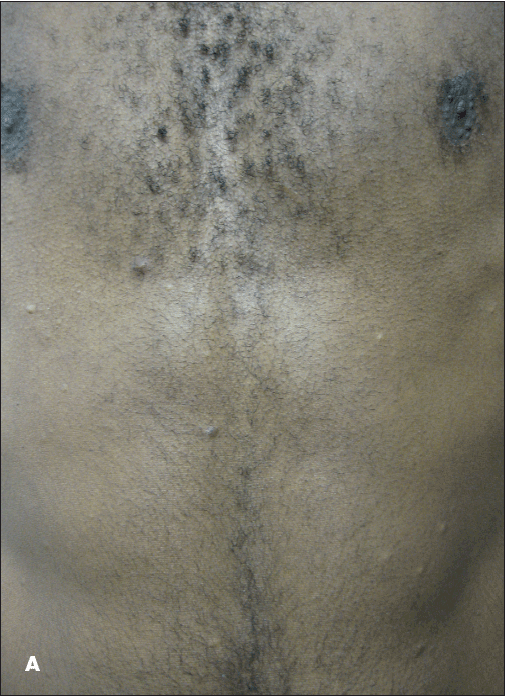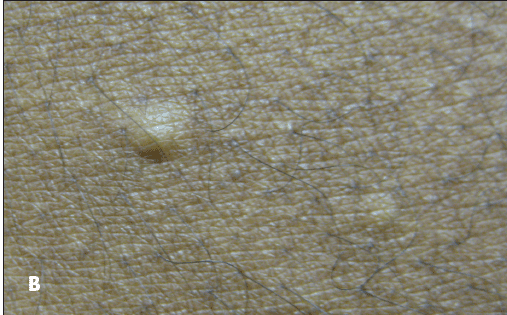Eruptive Vellus Hair Cysts
A 24-year-old man was concerned about the small “bumps” on his abdomen that had been increasing in number over the past several years. They were asymptomatic. The patient denied a family history of similar lesions. Examination revealed about 15 to 20 scattered, nontender, skin-colored/bluish, firm 2 to 3-mm papules on the abdomen. No other cutaneous/mucosal findings were noted.

A 24-year-old man was concerned about the small “bumps” on his abdomen that had been increasing in number over the past several years. They were asymptomatic. The patient denied a family history of similar lesions. Examination revealed about 15 to 20 scattered, nontender, skin-colored/bluish, firm 2 to 3-mm papules on the abdomen (A and B). No other cutaneous/mucosal findings were noted.
Based on the morphology of the lesions, a diagnosis of eruptive vellus hair cysts was made. These cysts most commonly present as numerous tiny dome-shaped dermal papules on the trunk; they range from skin-colored to darkly pigmented. The condition may be inherited in an autosomal dominant pattern.1 Its onset is usually between 17 and 24 years, although some cases are congenital.2
Diagnosis is often clinical and is confirmed with punch biopsy and histological examination of the specimen. 3 The pathogenesis involves an initially abnormal vellus hair follicle with keratinous plugs at the follicular infundibulum. These plugs deflect vellus hair shafts to the deeper part of the follicle; this results in cystic dilatation and gradual disruption of the continuity between the proximal and distal follicle.4
Eruptive vellus hair cysts have been reported in the setting of pachyonychia congenita type 2 and in association with mutations in the gene that encodes keratin 6b and 17.1 Pachyonychia congenita is a rare autosomal dominant disorder that is present at birth or within the first few months of life. In addition to eruptive vellus hair cysts, this condition usually causes subungual hyperkeratosis, follicular hyperkeratosis of the skin on the extensor extremities, steatocystoma multiplex, and oral leukokeratosis.5 This patient had none of these other symptoms.
Incision and drainage of the cysts, needle evacuation, topical retinoic acid or lactic acid (or other keratolyic agents), laser ablation, and transepidermal elimination of cyst products may be tried; however, most lesions persist indefinitely.1 This patient declined invasive treatment and was given benzoyl peroxide wash to use daily on the affected areas; he was warned that complete resolution is unlikely.

References:
REFERENCES:
1.
Bolognia JL, Jorizzo JL, Rapini RP, eds.
Dermatology.
2nd ed. Philadelphia: Elsevier Limited; 2008:chap 110.
2.
James WD, Berger TG, Elston DM.
Andrew’s Diseases of the Skin: Clinical Dermatology.
10th ed. Philadelphia: Saunders; 2005:680.
3.
Hong SD, Frieden IJ. Diagnosing eruptive vellus hair cysts.
Pediatr Dermatol.
2001;18:258-259.
4.
Tomková H, Fujimoto W, Arata J. Expression of keratins (K10 and K17) in steatocystoma multiplex, eruptive vellus hair cysts, and epidermoid and trichilemmal cysts.
Am J Dermatopathol.
1997;19:250-253.
5.
Spitz JL.
Genodermatoses: A Clinical Guide to Genetic Skin Disorders.
2nd ed. Philadelphia: Lippincott Williams & Wilkins; 2004:294.